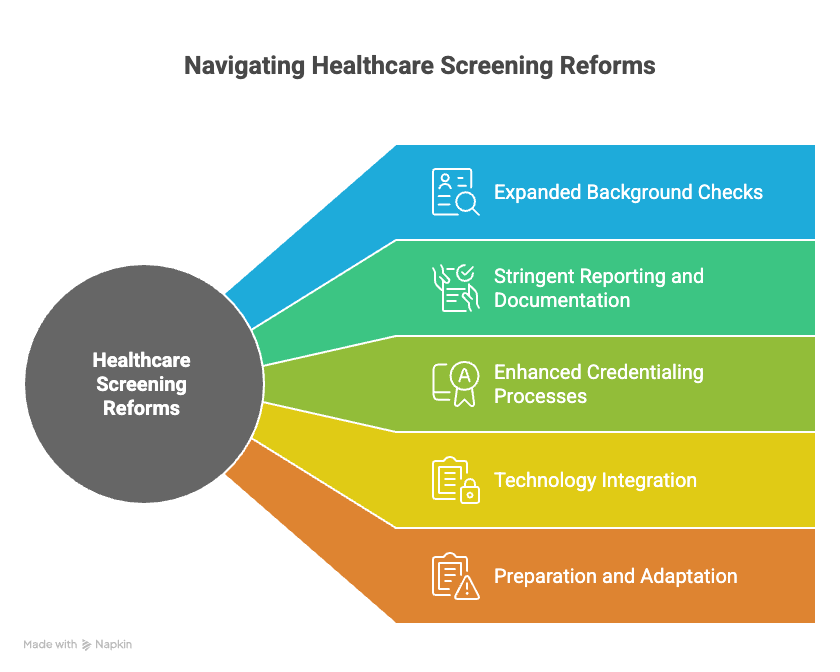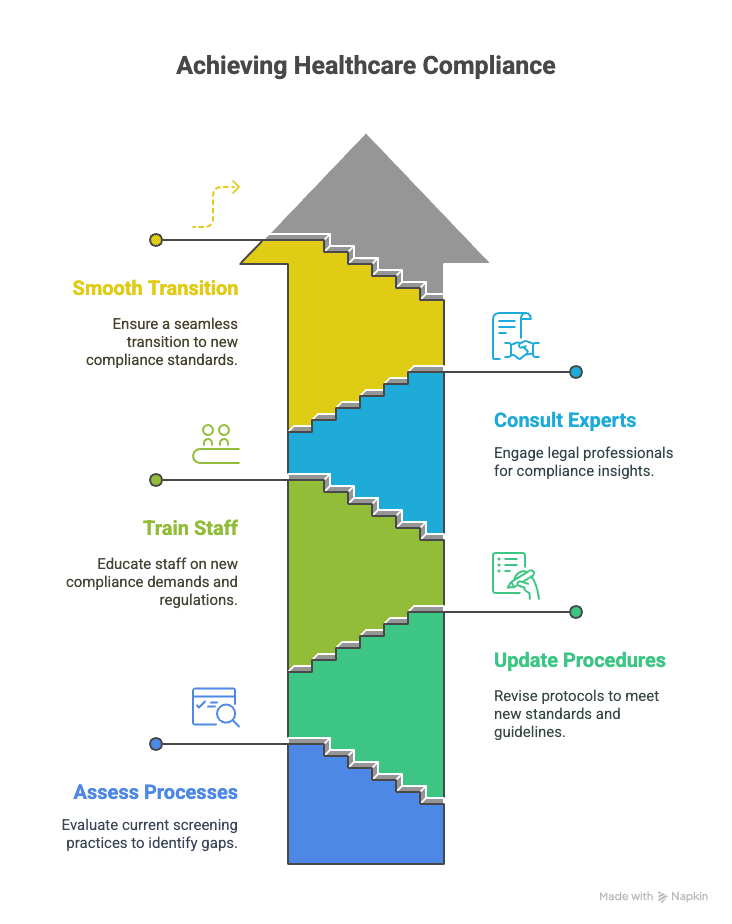The healthcare industry is bracing for significant changes in regulatory compliance with upcoming federal reforms in medical staff screening. These reforms aim to enhance the safety and reliability of healthcare services by tightening the standards for medical staff background checks. This guide is designed to help healthcare HR professionals, administrators, and facilities navigate the evolving landscape and ensure compliance with the new regulations.
Key Takeaways
- Upcoming changes in healthcare background checks will enhance the details required for criminal and credential verifications, impacting hiring processes.
- Facilities should review and update their current procedures to align with new federal and state regulations to avoid compliance issues.
- Leveraging technology can streamline the updates in verification processes and documentation, helping ensure accuracy and efficiency.
- Balancing comprehensive checks with privacy considerations is essential to maintain trust and avoid legal challenges.
- These reforms can improve patient safety and facility reputation, with potential long-term financial benefits by reducing risks and enhancing service quality.
Introduction
Background checks play a crucial role in maintaining high standards of safety and competence in healthcare. They help ensure that medical staff possess the necessary credentials and character to provide patient care. The importance of these screenings can't be underestimated, as they directly impact patient safety and trust in healthcare institutions.
Upcoming reforms in medical staff screening are set to strengthen these standards. These changes focus on enhancing the robustness of background checks to create a safer healthcare environment. As these new laws approach, the need for updated procedures and practices becomes more evident. That's where this article steps in.
Its purpose is to guide healthcare facilities through these upcoming changes. You'll discover insights into the reforms themselves, their implications for your organization, and strategies to effectively prepare and comply. With this information in hand, you can confidently align your screening processes with the latest regulations.
Understanding the Upcoming Healthcare Background Check Laws
Current regulations in medical staff background checks focus on ensuring that healthcare professionals have the qualifications and credentials necessary to provide safe and competent care. This typically involves verifying educational credentials, checking for any past criminal activity, and confirming previous employment history. However, as part of the upcoming federal reforms, these checks are set to become more stringent.
The new reforms introduce several key changes. One major shift is the expansion of the criteria for checks: facilities will now need to conduct more comprehensive criminal background checks that cover a wider array of offenses. Another important addition is mandated checks for history related to controlled substance usage, reflecting concerns about prescription drug abuse in the healthcare sector. Importantly, the reforms will require periodic re-verification of credentials, not just initial checks, adding an ongoing element to compliance.
These changes are expected to be enforced within the next two years, with specific timelines potentially varying based on geographic and operational factors. The federal reforms might set benchmarks, but states may have their own layers of regulations. This means you'll need to navigate both federal and state guidelines to maintain compliance. Close attention to these distinctions can prevent costly non-compliance issues down the line.
You should ask yourself: how well does your current process align with these upcoming changes? Are there gaps in the re-verification process that need immediate attention? By preparing now, you will ensure a smooth transition and safeguard both your employees and patients from potential risks.
Key Areas of Change in Screening Regulations
New reforms will expand the criteria for background checks in healthcare, affecting what you need to examine when hiring medical staff. Expect to incorporate checks that go beyond basic criminal history and employment verification. This might include detailed reviews of an individual's educational credentials and any sanctions from medical boards.

The requirements for reporting and documentation will become more stringent. Meticulous record-keeping will ensure that all aspects of a candidate’s background are thoroughly documented. This means you will need a robust system to track every step of the screening process. Consider software solutions that streamline data management while maintaining confidentiality.
Changes in credentialing processes will become evident, requiring more thorough checks of licenses and certifications. As a part of these reforms, you will need to verify not only the validity of licenses but also scrutinize any disciplinary actions more deeply. Prepare to regularly update these checks to match shifting regulatory expectations.
Technology will play a central role in compliance. With digital advancements, online resources can offer more efficient ways to conduct background checks and manage documentation. Explore tools that automate portions of the screening process without compromising accuracy. Using online databases and verification services can speed up compliance while reducing room for human error.
The key here is preparation and adaptation. If your facility gets ahead of these changes now, the transition to compliance will be smoother. Remember, each regulation shift brings an opportunity to refine practices, making them more effective and reliable. Stay engaged with upcoming requirements and proactively manage your compliance strategy.
Preparing Healthcare Facilities for Compliance
You need to start by assessing your current processes. Scrutinize your existing screening practices to identify gaps. Are you only doing criminal background checks? What about verifying credentials or previous employment? A thorough review can spotlight areas that need enhancement.
Next, update your procedures. Revise your protocols to meet new standards. You might need to incorporate more comprehensive background checks or beef up your verification processes. Align your criteria with upcoming federal guidelines to avoid compliance hiccups.
Training and education are critical. Educate your staff about the new compliance demands. Ensure that those involved in hiring and credentialing understand the new regulations inside out. Workshops or seminars can be useful in updating your team.

Consult with legal experts. Consider engaging legal professionals to navigate the nuances of compliance. They can provide valuable insights to ensure you're covering all bases. Legal counsel could help avoid potential pitfalls, saving time and resources in the long run.
The earlier you prepare, the smoother the transition will be. Getting all stakeholders on the same page now can prevent future headaches, making your facility a frontrunner in regulatory compliance.
Challenges and Considerations
Balancing the need for compliance with respect for privacy isn't always straightforward. Background checks touch on sensitive areas of a candidate's personal history. You must decide how much information is truly necessary to ensure patient safety without overstepping privacy boundaries. Striking this balance is crucial for maintaining trust and avoiding legal pitfalls. Are your current practices respecting applicants’ privacy rights?
Financial resources can't be ignored. Implementing new reforms could strain budgets, especially for smaller facilities. You might face costs for technology upgrades, additional staffing, and training. Proper planning is vital. Have you evaluated the financial impact of these changes and allocated resources effectively? Consider where to cut costs without compromising quality.
Ensuring fair hiring practices remains essential, even under stricter regulations. Some candidates might face unfair treatment due to background check results that aren't relevant to job performance. Align your hiring standards with principles of equity, focusing on pertinent information. How will your facility ensure fairness and consistency in hiring while meeting new requirements?
Understanding these challenges now can set the stage for smoother implementation. Engaging with these issues proactively might help prevent them from becoming obstacles later.
Potential Benefits of the Reforms
Federal reforms in healthcare background checks aren't just a paperwork exercise. They offer tangible advantages that can positively impact both patients and providers. First, consider patient safety. By increasing the scrutiny on medical staff qualifications and histories, healthcare facilities can better prevent unsuited individuals from entering the workforce. This means fewer risks of malpractice or negligence, leading to safer patient environments.
Next, let's talk about reputation. An organization that complies with rigorous screening standards demonstrates a commitment to excellence and safety. This can boost public trust and attract quality staff and patients. Reputation in healthcare matters, not just for patient confidence but also for partnerships and funding. Compliance makes a statement: this facility cares about integrity and quality.
Financially, the benefits might not be immediate, but they are significant. More thorough background checks can translate into long-term savings. By hiring competent and cleared staff from the get-go, facilities reduce the likelihood of costly legal battles and settlements down the road. Additionally, well-qualified staff mean better service, potentially leading to fewer errors and more efficient operations.
Have you assessed how these benefits align with your current policies? Are you prepared to leverage them to enhance your facility’s standing in the community? These are practical questions to consider as you prepare for these upcoming changes. Compliance today can be a cornerstone of success tomorrow.
Case Studies and Real-World Examples
Examples of Successful Implementation:
Consider Mercy Hospital in Nebraska. They revamped their entire background check system when similar state-level regulations kicked in two years ago. By collaborating with a tech firm, they integrated a new digital platform that syncs with state databases. This streamlined their background checks, saving time and reducing errors. Within six months, they reported a 30% reduction in hiring process delays, enhancing overall operational efficiency.
Another example is Riverside Health Clinic in Florida. Faced with stringent state checks, they adopted a more rigorous screening protocol. They added steps like social media reviews and updated fingerprinting procedures. These changes not only aligned them with state laws but also boosted staff quality. Feedback from patients improved, and incident reports decreased by 15%, directly correlating compliance with better patient care.
Lessons Learned:
From these examples, one clear takeaway is the importance of using technology to ease transition. You might worry about initial costs, but long-term savings and efficiency gains often outweigh these early expenses. Developing a robust training program for HR staff is another crucial aspect. Both Mercy Hospital and Riverside Health Clinic invested in staff education, which ensured consistent compliance and minimized disruption during the transition.
As you consider adapting to upcoming federal reforms, reflect on these examples. Are you ready to integrate new technology or adjust your screening process? How will you train your staff to meet these new standards? These real-world cases show that proactive measures can lead to smoother transitions and better institutional outcomes.
Conclusion
As you prepare for these impending federal reforms, your awareness and proactive planning will be crucial. Recognize the transformative impact these regulations can have on your operations. Start by reviewing your current screening processes. Identify gaps and areas for improvement to align with the new standards. Engage with legal and HR experts to ensure your strategies are comprehensive and compliant. Remember, staying ahead means not just meeting compliance but potentially improving your organization’s efficacy and safety. Consider accessing additional resources for further guidance, such as the Department of Labor’s website on hiring practices or specialized legal consultants in healthcare compliance. Proactivity is your ally in navigating these changes smoothly.
Frequently Asked Questions (FAQs)
What are the new federal rules for medical staff screening?
The federal government has updated its guidelines to ensure healthcare facilities conduct thorough screenings of medical staff. This includes verifying credentials, checking for any history of disciplined actions, and assessing ongoing competence. They emphasize the importance of regular audits and checks for maintaining quality care.
Are background checks for hospital staff federally mandated?
Yes, federal regulations require background checks for hospital staff. These checks include criminal history, license verification, and any prior disciplinary actions in other states or facilities. This ensures that all staff members uphold high standards of safety and professionalism.
How often should hospitals screen medical professionals?
Hospitals should conduct screenings upon hiring, during credential renewals, and whenever there is a significant change in a professional's status. Periodic re-evaluations every few years are also recommended to ensure ongoing compliance with federal standards.
What is continuous license monitoring and will it be required?
Continuous license monitoring is a process that automatically checks for updates on a professional’s credentials and any disciplinary actions. While not mandatory in all states, it is becoming a standard practice as it helps healthcare organizations maintain compliance with federal regulations efficiently.
How do you prepare for a federal screening compliance audit?
To prepare, ensure all records are up-to-date and organized. Conduct internal audits regularly to spot any discrepancies. Training staff on compliance standards and maintaining clear documentation of all processes can help your facility smoothly navigate an audit.
What are the consequences of noncompliance with federal screening rules?
Noncompliance can lead to fines, legal actions, and loss of accreditation. It could also jeopardize patient safety and the facility's reputation. Ensuring compliance protects both the organization and the individuals it serves.
Do these screening rules apply to temporary or contract medical staff?
Yes, the same federal screening rules apply to all medical staff, including temporary and contract workers. This ensures that every individual working in a healthcare setting meets the required standards for patient safety and care.
What role does technology play in medical staff screening?
Technology streamlines the screening process, providing tools for license monitoring, automated background checks, and data verification. This can significantly reduce the administrative burden and help maintain compliance with federal guidelines.
How can healthcare facilities stay updated on changes to federal screening rules?
It is crucial to subscribe to updates from federal agencies such as the Centers for Medicare & Medicaid Services and regularly review bulletins from professional healthcare organizations. Engaging in professional networks and attending relevant workshops can also help facilities stay informed.
Definitions
Employment Verification
Employment verification confirms a candidate’s past or current job roles, responsibilities, and dates of employment. This step helps you validate that the individual has the experience listed on their resume. It may also include checking reasons for departure or eligibility for rehire. Accurate employment verification protects your facility from hiring underqualified staff.
Credentialing
Credentialing is the process of verifying a professional's qualifications, including education, licensure, and certifications. In healthcare, this confirms that staff meet required standards to perform their duties safely and legally. You can support credentialing with online databases, direct contact with issuing bodies, or specialized software tools. Are your staff credentials up-to-date?
Background Check
A background check is a screening procedure that reviews a candidate’s history for factors like criminal records, identity validation, and sanction lists. In the healthcare setting, checks also look for license suspensions or drug-related offenses. More thorough background checks reduce hiring risks and improve patient safety. How detailed is your current check?
Compliance
Compliance means following all relevant laws, rules, and policies that govern hiring and credentialing. For medical facilities, this includes both federal and state regulations related to staff qualifications and background screenings. Falling behind on compliance can lead to penalties or legal issues. Have you reviewed the latest updates?
Re-verification
Re-verification refers to the ongoing process of rechecking an employee’s credentials or background at regular intervals. It ensures staff remain qualified and have not developed disqualifying issues, like expired licenses or recent criminal charges. Many reforms now require routine re-verification. Do you have a schedule in place to maintain this?
References
- Florida HealthSource: https://flhealthsource.gov/background-screening/bgs-requirements/
- The HIPAA Journal: https://www.hipaajournal.com/background-checks-for-healthcare-employees/
